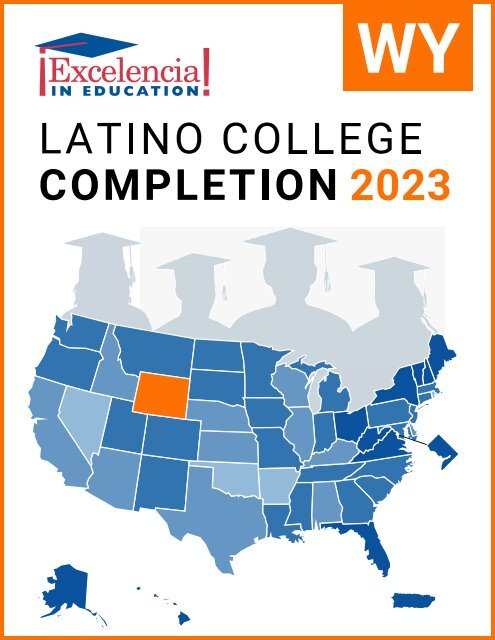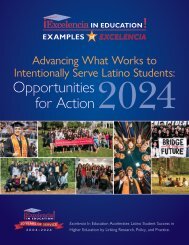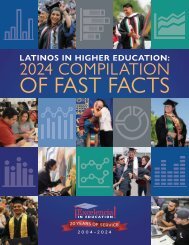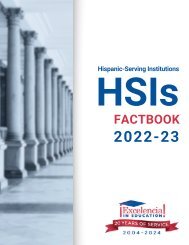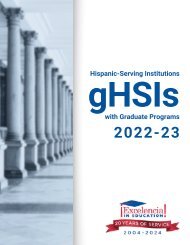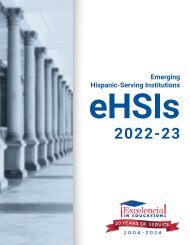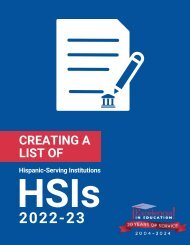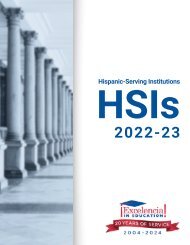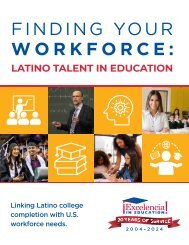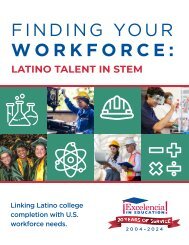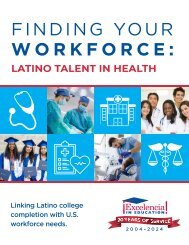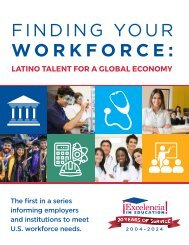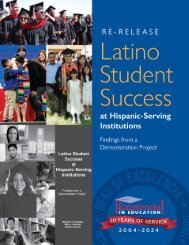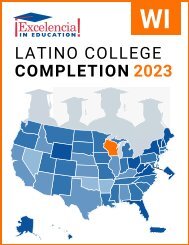Latino College Completion 2023: Wyoming
You also want an ePaper? Increase the reach of your titles
YUMPU automatically turns print PDFs into web optimized ePapers that Google loves.
WY
LATINO COLLEGE COMPLETION:<br />
WYOMING – <strong>2023</strong><br />
For the U.S. to regain the top ranking in the world for college degree<br />
attainment, <strong>Latino</strong>s will need to earn 6.2 million degrees by 2030. 1<br />
FAST FACTS<br />
STATE RANKING:<br />
<strong>Wyoming</strong> had the 42nd largest<br />
<strong>Latino</strong> population in the U.S.<br />
K-12 POPULATION:<br />
In <strong>Wyoming</strong>, 15% of the K-12<br />
population was <strong>Latino</strong>. 2<br />
POPULATION:<br />
In <strong>Wyoming</strong>, 11% of the population<br />
was <strong>Latino</strong>. 2<br />
MEDIAN AGE:<br />
The median age<br />
of Hispanics in<br />
<strong>Wyoming</strong> was 27,<br />
compared to 41<br />
for White non-<br />
Hispanics. 2<br />
27<br />
Hispanics<br />
41<br />
White<br />
non-Hispanics<br />
ENROLLMENT:<br />
In <strong>Wyoming</strong>, 28% of Hispanics<br />
(ages 18 to 34) were enrolled in higher<br />
education, compared to 18% of<br />
White non-Hispanics. 2<br />
DEGREE ATTAINMENT:<br />
In <strong>Wyoming</strong>, 31% of Hispanic<br />
adults (25 and older) had earned an<br />
associate degree or higher, compared to<br />
43% of White non-Hispanic adults. 2<br />
Hispanic Adults = 3.1 of 10<br />
To reach the degree attainment goal by 2030, the U.S. can: close<br />
the degree completion gap by accelerating <strong>Latino</strong> completion while<br />
increasing for all students and scale up programs and initiatives that<br />
work for <strong>Latino</strong>, and all, students. The following demographics,<br />
institutional data, and practices inform <strong>Latino</strong> degree attainment.<br />
ENROLLING: Top 5 Institutions (Hispanic Undergraduates) in <strong>Wyoming</strong>, 2021-22<br />
Institution<br />
Sector<br />
Grand<br />
Total<br />
Hispanic<br />
Total<br />
5 – – – – –<br />
NOTE: We use the terms <strong>Latino</strong> and Hispanic interchangeably in this factsheet.<br />
Source: Excelencia in Education analysis using U.S. Department of Education, National Center for<br />
Education Statistics (NCES), Integrated Postsecondary Education Data System (IPEDS), 2021 Fall<br />
Enrollment, Graduation Rates Survey and Institutional Characteristics Survey.<br />
%<br />
Hispanic<br />
1 University of <strong>Wyoming</strong> Public, 4-year 8,700 657 8%<br />
2 Laramie County Community <strong>College</strong> Public, 4-year 2,489 415 17%<br />
3 Western <strong>Wyoming</strong> Community <strong>College</strong> Public, 4-year 1,394 218 16%<br />
4 Casper <strong>College</strong> Public, 2-year 2,358 211 9%<br />
Private forprofit,<br />
2-year<br />
5 WyoTech<br />
742 139 19%<br />
ASSOCIATE DEGREES: Top 5 Institutions Awarding to Hispanics in <strong>Wyoming</strong>, 2020-21<br />
Institution<br />
Sector<br />
Grand Hispanic %<br />
Total Total Hispanic<br />
1 Laramie County Community <strong>College</strong> Public, 4-year 497 65 13%<br />
Northern <strong>Wyoming</strong> Community <strong>College</strong><br />
2 District<br />
Public, 2-year 505 45 9%<br />
3 Casper <strong>College</strong> Public, 2-year 520 42 8%<br />
4 Western <strong>Wyoming</strong> Community <strong>College</strong> Public, 4-year 248 36 15%<br />
5 Central <strong>Wyoming</strong> <strong>College</strong> Public, 4-year 209 25 12%<br />
BACHELOR DEGREES: Top 5 Institutions Awarding to Hispanics in <strong>Wyoming</strong>, 2020-21<br />
Institution<br />
Sector<br />
Grand<br />
Total<br />
Hispanic<br />
Total<br />
%<br />
Hispanic<br />
1 University of <strong>Wyoming</strong> Public, 4-year 2,120 132 6%<br />
2 – – – – –<br />
3 – – – – –<br />
4 – – – – –<br />
White Adults = 4.3 of 10<br />
1 Projections to 2030: Excelencia in Education. (2020). Ensuring America’s Future: Benchmarking <strong>Latino</strong><br />
<strong>College</strong> <strong>Completion</strong> to 2030. Excelencia in Education. Washington, D.C.<br />
2 U.S. Census Bureau, 2021 American Community Survey 1-Year Estimates
<strong>Wyoming</strong> Gap in Degree <strong>Completion</strong><br />
Closing the degree completion gap can be tracked<br />
by the 4 measures shown below. Alone, none<br />
of these measures capture the entire “story” of<br />
degree completion. However, in combination,<br />
they provide a useful picture of the gap in degree<br />
attainment between Hispanic and White non-<br />
Hispanic cohorts in a single year.<br />
Graduation Rate — Total percentage of students<br />
who graduated within 150% of normal time for<br />
first-time, full-time freshmen. This incorporates<br />
students that graduated in 3 years at two-year<br />
institutions, or in 6 years at four-year institutions.<br />
Transferred to Another Institution —<br />
Percentage of students that transferred to another<br />
institution and did not complete a degree.<br />
Still Enrolled — Percentage of students that are<br />
still enrolled at the point of 150% normal time to<br />
completion.<br />
No Longer Enrolled — Percentage of students<br />
that are no longer enrolled at the point of 150%<br />
normal time to completion.<br />
At two-year institutions, Hispanics’<br />
graduation rate was 9%-points<br />
lower than that of their White<br />
non-Hispanic peers in <strong>Wyoming</strong>.<br />
TWO-YEAR INSTITUTIONS<br />
33%<br />
6%<br />
15%<br />
46%<br />
WHITE<br />
37%<br />
DEGREE OUTCOMES<br />
■ No Longer Enrolled<br />
At four-year institutions, Hispanics’<br />
graduation rate was 13%-points<br />
lower than that of their White<br />
non-Hispanic peers in <strong>Wyoming</strong>.<br />
FOUR-YEAR INSTITUTIONS<br />
9%<br />
16%<br />
■ Still Enrolled<br />
■ Transferred to<br />
Another Institution<br />
20%<br />
-9% -13%<br />
■ Graduation Rate<br />
51%<br />
37%<br />
HISPANIC<br />
*Percentages may not add up to 100% due to rounding.<br />
24%<br />
5%<br />
WHITE<br />
32%<br />
4%<br />
26%<br />
38%<br />
HISPANIC<br />
NOTE: Outcomes shown are for students at two-year institutions who started in Fall 2018, and<br />
for students at four-year institutions who started in Fall 2015.<br />
Source: Excelencia in Education analysis using the U.S. Department of Education, National<br />
Center for Education Statistics (NCES), Integrated Postsecondary Education Data System, 2021<br />
Graduation Rates Survey and the Institutional Characteristics Survey.<br />
Examples of What Works for <strong>Latino</strong> Students<br />
There are institutions showing success in enrolling, retaining, and graduating <strong>Latino</strong> students. The following are examples of<br />
programs across the country with evidence of effectiveness in serving <strong>Latino</strong> students nominated for Examples of Excelencia.<br />
The Joaquin Bustoz Math-Science Honors Program (JBMSHP) at<br />
Arizona State University is an intense academic program that provides<br />
motivated high school students the opportunity to begin university<br />
mathematics studies before graduating high school. JBMSHP aims to<br />
increase the number of underrepresented students in the mathematics/<br />
science fields and increase college access for underrepresented students.<br />
JBMSHP offers participants a summer residential mathematics program for<br />
motivated high school students interested in academic careers requiring<br />
mathematics, science, or engineering-based coursework. Students join<br />
a community of peers with similar interests and interact with dedicated<br />
and experienced faculty and staff who closely monitor student progress.<br />
Participants live on the Arizona State University (ASU) Tempe campus<br />
while enrolled in a university-level mathematics course for college credit<br />
and conduct research to present at a poster symposium. Tutoring is<br />
also available for students as they participate in the program. Tuition,<br />
room and board, textbooks, and classroom expenses are provided for<br />
participants. JBMSHP creates an environment where students can focus<br />
on their studies, develop a strong academic work ethic, and become<br />
familiar with the university environment, resources, and faculty.<br />
Of all program alumni since 1985, 58% are Hispanic. As of 2020, 72%<br />
of all JBMSHP alumni have graduated with an undergraduate or graduate<br />
degree. This is a 2% increase from 2016. At ASU, JBMSHP alumni also earn<br />
higher grade point averages than their non-JBMSHP counterparts. Fifty-two<br />
percent (52%) of all JBMSHP alumni degrees earned were Hispanic. From<br />
inception until 2017, 178 JBMSHP alumni have earned a graduate degree.<br />
For more information on institutional programs improving <strong>Latino</strong> student success in higher education, access Excelencia in<br />
Education’s Growing What Works database at http://www.edexcelencia.org/growing-what-works<br />
ENSURING AMERICA’S FUTURE BY INCREASING LATINO COLLEGE COMPLETION • WWW.EDEXCELENCIA.ORG


